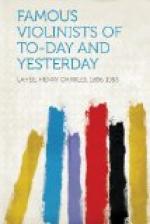Tartini’s contemporaries all agree in crediting him with those qualities which make a great player. He had a fine tone, unlimited command of finger-board and bow, enabling him to overcome the greatest difficulties with remarkable ease, perfect intonation in double stops, and a most brilliant shake and double-shake, which he executed equally well with all fingers. The spirit of rivalry had no place in his amiable and gentle disposition. Both as a player and composer Tartini was the true successor of Corelli, representing in both respects the next step in the development of the art.
Tartini lived until the year 1770. He had, as Doctor Burney says, “no other children than his scholars, of whom his care was constantly paternal,” Nardini, his first and favourite pupil, came from Leghorn to see him in his sickness and attend him in his last moments with true filial affection and tenderness. He was buried in the Church of St. Catharine, a solemn requiem being held in the chapel of San Antonio, and at a later period his memory was honoured by a statue which was erected in the Prato della Valle, a public walk at Padua, where it may be seen among the statues of the most eminent men connected with that famous university.
Jean Marie Leclair, a pupil of Somis, was a Frenchman, born at Lyons, and he began life as a dancer at the Rouen Theatre. He went to Turin as ballet master and met Somis, who induced him to take up the violin and apply himself to serious study. On returning to Paris, he was appointed ripieno-violinist at the Opera, and in 1731 became a member of the royal band, but he, although undoubtedly superior to any violinist in Paris at that time, never seems to have made much of a success, for he resigned his positions and occupied himself exclusively with teaching and composition, and it is on the merits of his works that he occupies a high place among the great classical masters of the violin. Leclair was murdered late one night close to the door of his own house, shortly after his return from Amsterdam, to which place he had gone solely for the purpose of hearing Locatelli. No motive for the crime was ever discovered, nor was the murderer found.
Gaetano Pugnani was a native of Turin, and to him more than to any other master is due the preservation of the pure, grand style of Corelli, Tartini, and Vivaldi, for he combined the prominent qualities of style and technique of all three. He became first violin to the Sardinian court in 1752, but travelled extensively. He made long stays in Paris and London, where he was for a time leader of the opera band, and produced an opera of his own, also publishing a number of his compositions. In 1770 he was at Turin, where he remained to the end of his life as teacher, conductor, and composer.




